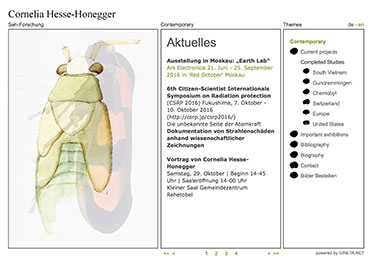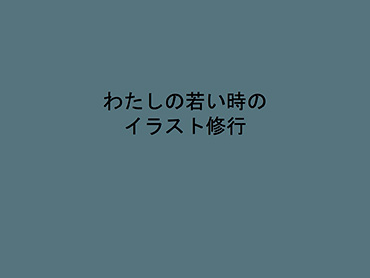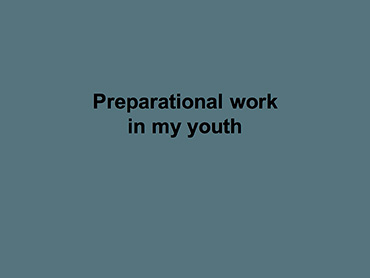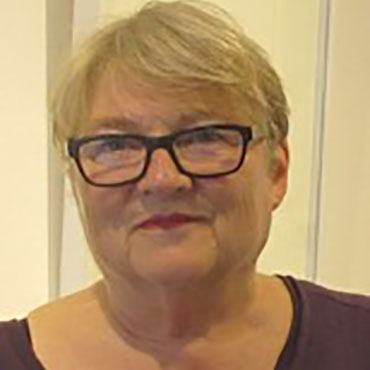Cornelia Hesse-Honegger
コルネリア・ヘッセ=ホネガ―
コルネリア・ヘッセ=ホネガ―
科学イラストレーター/Scientific illustrator
スイスのチューリヒにて、芸術家の両親のもとに生を受ける(母はウォーリャ・ラヴァター、父はゴットフリート・ホネガー)。両親および妹とともに、スイスの他、ニューヨークとパリで成長。チューリヒ大学動物学部で科学イラストレーターとして訓練を受けたのち、同大学で25年間勤務。主な業務は分類学的同定および遺伝学研究のためにハエを描写することだった。1967年、突然変異を起こしたミバエの描写の仕事に任命され、イラストレーターとして自らのスタイルの構築を開始。突然変異した虫の、困惑しているかのような顔は、ヘッセ=ホネガ―のキャリアに大きな影響を与えた。
その後、郊外で、夫および2人の息子と暮らしながら、方眼紙に半翅目の昆虫や蜘蛛、テントウムシを描き始める。1985年、研究室で突然変異を起こしたハエを描く仕事に戻ることを決意。突然変異したハエを、人工的な「自然」のプロトタイプと見なしてのことであった。ハエは、1960年代の薬品汚染の代わりに、X線照射を受けていた。1986年4月26日、チェルノブイリ事故が起こり、ヨーロッパ全体が放射能汚染を受けた。研究室で見られるのと同じ突然変異を持つ昆虫が汚染地域に存在する可能性を考え、「目に見える影響はないだろう」という大学の同僚の科学者たちの意見に逆らい、1987年夏、西ヨーロッパで汚染が一番ひどかった、スウェーデン東部を訪問。初めて、奇形を持つ、動作が正常ではない半翅目の昆虫を見つけ、ホテルに帰ってスケッチをした。1988年1月、自らの発見をスイスの一流誌に発表。「これらの虫の突然変異は、チェルノブイリの放射性降下物のせいである」と断言し、それによって科学者から批判を受けた。1989年、前年夏にスイスの原子力発電所周辺で採集した、突然変異を起こした虫について同じ雑誌で発表した時には、この批判はいっそう強くなり、科学者コミュニティーで「村八分」をとなった。
原子力による放射線の影響についてさらに学ぶべく、研究領域を英国セラフィールドの再処理工場、フランスのラ・アーグ再処理工場、ドイツのクリュンメル原発、シュターデ原発、グンドレミンゲン原発に拡大。さらに米国で、スリーマイル島、ネバダ州およびユタ州の核実験場、ワシントン州のハンフォード核施設周辺を訪れた。訪れた場所すべてで、夥しい数の突然変異があることを確認した。1990年、ついにチェルノブイリ原発を訪れる機会を得、現地でカスミカメムシを採集した。2004年、ベトナム戦争時代に枯れ葉剤が撒かれた地域から、半翅目の昆虫を採集し、研究し、図画化した。
ヘッセ=ホネガ―の、現地を訪問しての研究や奇形を図画化する作業は、最高の状態で保守されている原発からの低線量放射線でさえ、自然に対してのみならず、人類にも大きな危険がある点を明らかにする。この事実を私達が無視して来られたのは、損傷が目で確認できなかったからである。ヘッセ=ホネガ―にとって、目で見て、見えるようにするプロセスは、図画化と深く関係しあっている。2015年、「核のない未来賞(Nuclear Free Future Award)」を受賞。
生活費と研究費を得るため、チューリヒにあるシルクのメーカー、Fabric Frontline社に、1986年から2008の間にクチュール用シルクのデザイン75点を提供。チューリヒ・ユニバーシティ・オブ・ザ・ピープル、ドイツのヨハネス・グーテンベルク大学マインツ、ベルン大学、チューリヒのF+F アートスクールで科学イラストを教えるとともに、英国、アイルランド、米国でワークショップを開催。
展覧会および出版物多数。自身の著作は以下のとおり。
Cornelia Hesse-Honegger.Warum bin ich in Österfärnebo? Edition Heuwinkel,Carouge, Switzerland,1989.
Cornelia Hesse-Honegger. Nach Tschernobyl, Eidgenössisches Bundesamt für Kultur, Bern, Switzerland,1992.
Cornelia Hesse-Honegger, et al. The Future’s Mirror. Locus+, Newcastle upon Tyne, England, 1997.
Cornelia Hesse-Honegger. Heteroptera das Schöne und das Andere oder Bilder einer mutierenden Welt. Verlag Zweitausendeins, Leipzig, Germany, 1998, and Steidl, Göttingen, Germany, 2000.
Cornelia Hesse-Honegger. Heteroptera, The Beautiful and the Other, Verlag Scalo, Zurich, Switzerland, 2001.
Cornelia Hesse-Honegger and Peter Wallimann. 2008. Malformation of True Bug (Heteroptera): a Phenotype Field Study on the Possible Influence of Artificial Low Level Radioactivity. Chemistry& Biodiversity, Volume 5, No. 4, pp. 499–539.
Cornelia Hesse-Honegger. Die Macht der schwachen Strahlung – was uns die Atomindustrie verschweigt. Edition Zeitpunkt, Solothurn, Switzerland, 2016.
ウェブサイトはhttp://www.wissenskunst.ch
Cornelia Hesse-Honegger was born in Zürich Switzerland, both parents artists, Warja Lavater and Gottfried Honegger. With her parents and sister she lived as well in New York and Paris. After an apprenticeship as a scientific illustrator at the zoological department at the University of Zurich, she worked for twenty-five years at the institute, mostly drawing flies for taxonomic identification and genetic studies. 1967, she had been given the assignment to draw mutated fruit flies, which she then started also to paint developing her own style. The disturbed faces of these mutated insects had a deep impact on her future.
Living with her own family husband and two sons in the countryside, she started to paint true bugs, spiders, and ladybird beetles on graph paper. In 1985, she decided to go back to painting mutated laboratory flies, considering them to be the future prototypes of a new man-made Nature. No longer poisoned with chemicals as they had been in the 1960s, these later generations were irradiated with X-rays. And then on 26 April 1986, the accident at Chernobyl occurred, irradiating all of Europe. She imagined that insects in contaminated areas would necessarily show some of the same mutations I had seen in the laboratory, and, ignoring the scientists of the institute who explained to her that no visible effects could be expected, in the summer of 1987 she traveled to eastern Sweden where the radiation had been highest in Western Europe. There, she found her first deformed and crippled true bugs, which she painted in the hotel room. In January 1988 she published her findings in a major Swiss magazine, declaring that the deformed insects were caused by the nuclear fallout from Chernobyl. This statement caused critical reactions from scientists. It became worse when in 1989 she published in the same magazine her findings of disturbed insects collected around Swiss nuclear power plants in summer 1988. She became a pariah of her professional community.
In order to learn more about the effects of nuclear radiation she extended her studies to the areas around the nuclear reprocessing plants in Sellafield, UK; La Hague, France; nuclear power plants Krümmel, Stade, and Gundremmingen, Germany. In the US, I traveled to Three Mile Island, to the nuclear test grounds in Nevada and Utah, and to the areas surrounding the atomic bomb factories around Hanford, Washington. She confirmed a staggering array of mutations around all these sites. In 1990, she finally had the opportunity to travel around the Chernobyl nuclear power plant and collect leaf bugs. In 2004 she collected, studied and painted true bugs from areas hit by Agent Orange during the Vietnam War.
Because of this research in the field, as well as through the act of describing these deformities through the pictorial process, she can show that “low radiation” emitted from even the best-maintained nuclear plants is in fact extremely dangerous to nature and, thus, also to human beings. In part, what has allowed us to ignore these facts is that we are incapable of seeing this damage. For her the process ‘seeing’ and of making visible is very much linked to making drawings. In 2015 she received the Nuclear Free Future Award.
To earn her living and finance her research she had been given the to paint designs for the Zürich based silk producer Fabric frontline, creating 75 designs for couture silks between 1986 to 2008. She was also a teacher for scientific illustration at the People’s University of Zürich, at the University Gutenberg in Mainz Germany, at the University of Bern, at F+F Art School in Zürich and workshops in UK Ireland and USA.
There were also a big number of exhibitions and publications and, she published also her own books
Cornelia Hesse-Honegger ‚Warum bin ich in Österfärnebo’ Edition Heuwinkel, 1989
Cornelia Hesse-Honegger ‚Nach Tschernobyl’, Eidgenössisches Bundesamt für Kultur, 1992
Cornelia Hesse-Honegger and authors ‚The Future’s Mirror, Locus +, 1997
Cornelia Hesse-Honegger, Heteroptera das Schöne und das Andere oder Bilder einer mutierenden Welt, Verlag Zweitausendeins, 1998 and Steidl 2000
Cornelia Hesse-Honegger, Heteroptera, The Beautiful and the Other, Verlag Scale
Cornelia Hesse-Honegger and Peter Wallimann ‚Malformation of True Bug (Heteroptera): a Phenotype Field Study on the Possible Influence of Artificial Low Level Radioactivity, Chemistry& Biodiversity, 2008 Volume 5, No 4 p 499 – 539
Cornelia Hesse-Honegger ‚Macht der schwache Strahlung, Was uns die Atomindustrie verschweigt, Edition Zeitpunkt 2016
www.wissenskunst.ch
講演資料:

Cornelia Hesse Honegger: Aktuelles

Cornelia_HH_JP
(画像をクリックしてダウンロード)
Speech Handouts:

Cornelia_HH_EN
(Click to download)
講演タイトル:
70年続く否定 ――人工放射能は自然に対しどのように有害か――
Title of the speech:
Seventy years of denial
How Artificial Radioactivity harms Nature
講演概要:
1986年のチェルノブイリ事故以来私は、チェルノブイリ事故で生じた放射性物質を含む雲が飛来した地域、および原子力発電所や再処理工場などの核施設で採集した昆虫、特に半翅目(異翅類)の昆虫の研究と図画化を行ってきた。主な関心分野は、私は大惨事だとみなしている、一般に「低線量」と呼ばれる放射能を排出する、正常に作動している核施設である。低線量の放射能は昆虫に奇形をもたらし、私はそれを図画化・文章化している。
Abstract:
Since the accident of Chernobyl 1986 I research and paint insects, mostly true bugs (Heteroptera) in areas hit by the radioactive cloud from Chernobyl and nuclear installations like nuclear power plants or nuclear reprocessing plants. My main interest are well functioning nuclear installations, which I consider a catastrophe, since they emit radioactivity in so called ‘low doses’. These low doses cause deformations on insects, which I paint and document.

